Uzalud vam trud svirači Prljavo kazalište Listen to it! Bm Em
1. Sto put sam se evo zakleo,
A7 D F#7
pred jutro te prevario.
Bm Em
Drugoj ja sam bagrem nosio,
A7 D
tebe iznevjerio.
2. Sto put sam se evo zakleo,
pa te prevario.
Sad bih dukate od jada
D0 F#7 Bm
Baš u blato bacio.
Refrain (2x):
Bm Em
A za oblak mi se mjesec skrio,
A7 D F#7
sakrio mi pute.
Bm Em
Uzalud vam trud svirači,
Bm F#7 Bm
za drugog su dunje žute.
2. A ja evo nekad sjetim se,
što moj ćaća znao reći je,
Sveti duše s idile slavonske,
uz pjesmu prebole, al ne oproste.
2xR.
3. Uz pjesmu mi se evo rodimo
uz pjesmu umiremo.
Slavonijo, tko te nije volio,
ne zna što je izgubio.
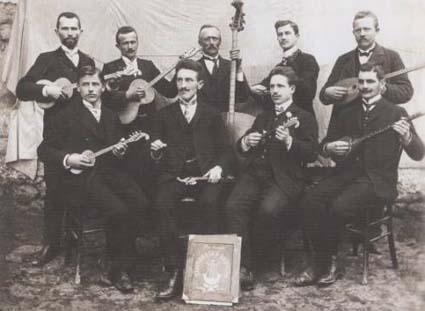
Croatian tamburitzans in Slovenia around 1910
S onu stranu Plive Traditional song of Bosnian Croats D A
1. S onu stranu Plive
Em A D
gajtan trava raste.
G D
Po njoj pasu ovce, |
Bm D A D | 2x
čuvalo ih mo - o - mče. |
2. Momče tužno plače,
još tužnije ječi:
Svaka tuđa zemlja
tuga je golema.
3. U tuđemu svijetu
bez oca i majke,
svaka tuđa zemlja
tuga je golema.
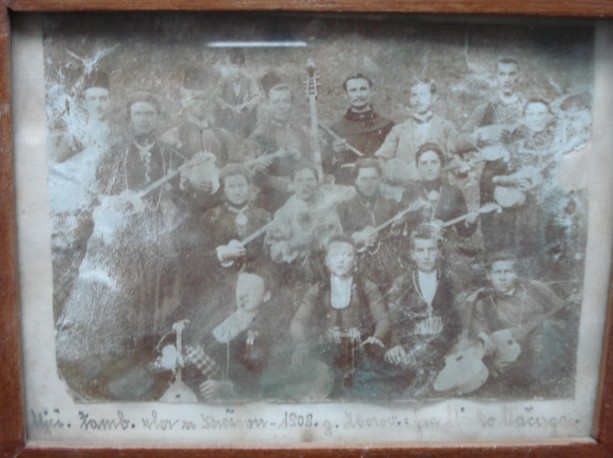
Mixed tamburitza orchestra from Kreševo, 1908, BiH
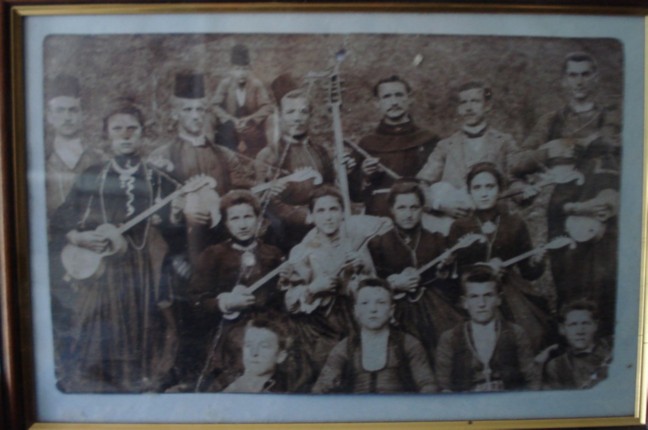
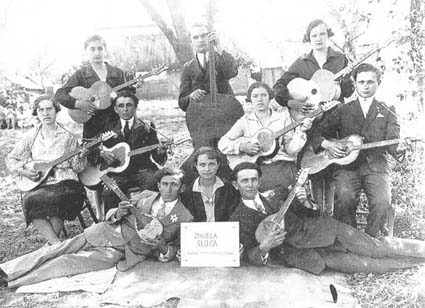
Virovitica (Živjela sloga), 1919
Another song by Zvonko Bogdan written in the sweet Croatian ikavian dialect.
PIVAJTE PISME BUNJEVAČKE! Hej, salaši Zvonko Bogdan A E E7 A
1. Hej, salaši na sjeveru Bačke,
A E E7 A
u vama su pisme bunjevačke.
A G7 F#7 Bm Dm
A tambura tako lipo svira, |
E A E A | 2x
ko da note par slavuja bira. |
R. Ni svatova nigdi takih nema,
ko kad baćo kćer na udaj' sprema.
Na snaši se bili šlajer vije,
ko kad zimi snig salaš pokrije.
2. Hej, Bunjevci na sjeveru Bačke!
Sačuvajte pisme bunjevačke!
Pivajte ih još puno godina,
vaša j' grana mala, al' je fina.
R. I lumpujte, al' lipo polako.
Nek se divi i nek vidi svako.
Pa nek vranci pokidaju štrange,
kad se krenu momci na vašange.
štrange = remenovi
vašange = maškare
The melody of the song Fijaker stari, for which Zvonko Bogdan wrote verses, is known in Croatia for very long, at least from the beginning of 20th century. Indeed, Bogdan has taken the melody of an old Croatian song Zrtva ljubavi, known at least from the beginning of the 20th century. I owe this information to Dunja Knebl, well known interpreter of old, forgotten Croatian songs, in particular from Međimurje. 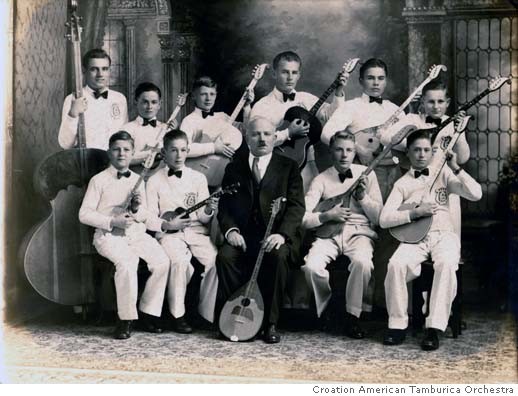
Those wishing to learn more about the history of Bačka Croats (Bunjevci and Šokci) may consult the following books written by Ante Sekulich (born in Backa): - Bački Hrvati - Narodni život i običaji, Zbornik za narodni život i običaje Južnih Slavena 52, JAZU (now HAZU - Croatian Academy of Sciences and Arts), Zagreb, 1991 (519 pages)
- Rasprave o jeziku bačkih Hrvata, Matica hrvatska, Zagreb, 1997 (291 pages)
- Umjetnost i graditeljstvo bačkih Hrvata, Matica hrvatska, Zagreb, 1998 (171 pages)
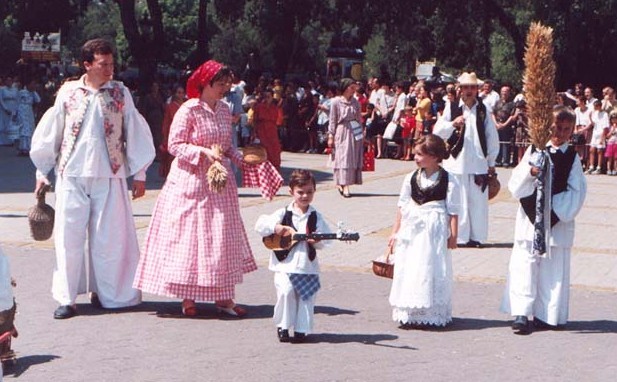
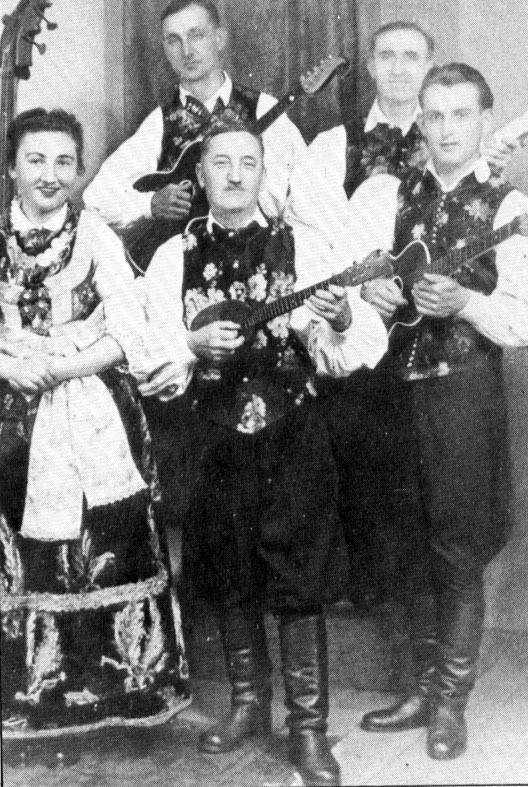
Another classic of tamburitza play, one of the most popular among the Bunjevci Croats in Bačka.
Kolo igra, tamburica svira verses by N. Kujundžić, music by S. Mukić D A D
1. Kolo igra, tamburica svira,
G G7 D
pisma ječi, neda noći mira.
Svud se čuje, svud se širom znade,
Da Bunjevac dušu ne izdade.
G C C0 G
R. Veseli se, svako mu se divi, |
D D7 G | 2x
nek se znade da Bunjevac živi! |
2. Nije majka rodila junaka,
ko' što j'sinak divnih Bunjevaka!
Nit će majka roditi junaka,
ko' Bunjevca, tak(v)og veseljaka.
R. Kolo vodi, svaki mu se divi,
nek se znade da Bunjevac živi!
3. Ni divojke ne biše u nane,
ko' što j'ćerka bunjevačke grane.
Svilu nosi, a zlatom se krasi,
crne oči, crne su joj vlasi!
R. Kolo igra, svaki joj se divi.
Nek se znade da Bunjevac živi!
4. Ori, pismo, tambur tamburice,
nek se čuju daleko ti žice.
Nek se gori, a i doli znade,
da Bunjevac dušu ne izdade!
R. Prelo kupi, svaki mu se divi.
Nek se znade da Bunjevac živi!
One of the greatest tamburitza players among Backa Croats was Pere Tumbas - Hajo (Bunjevac, dika Bacckih Hrvata iz bile Subotice). 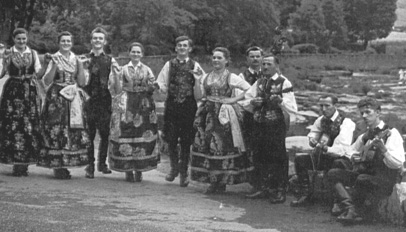
Hajo (third from the right) with his orchestra
in Langolen, England, 1952
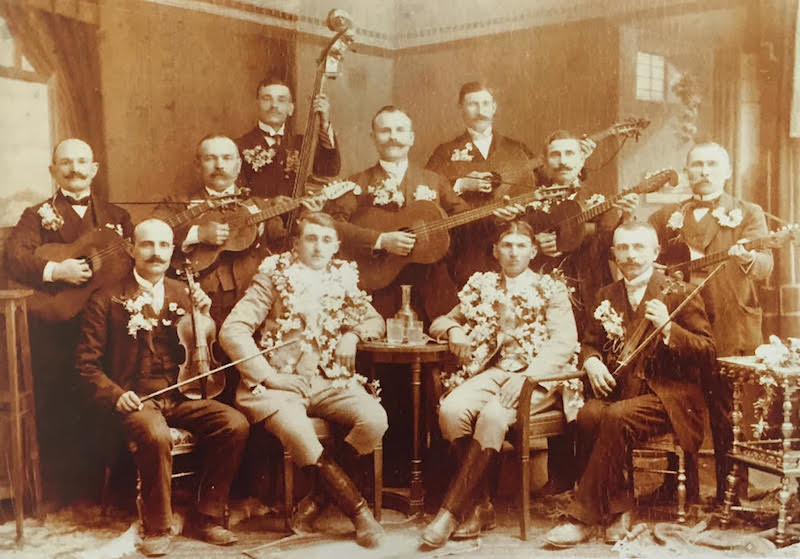
Bunjevci Croatians in Bačka: polivači accompanied with tamburitza orchestra, Subotica 1914.
Source Naco Zelić: Slikovali smo se.
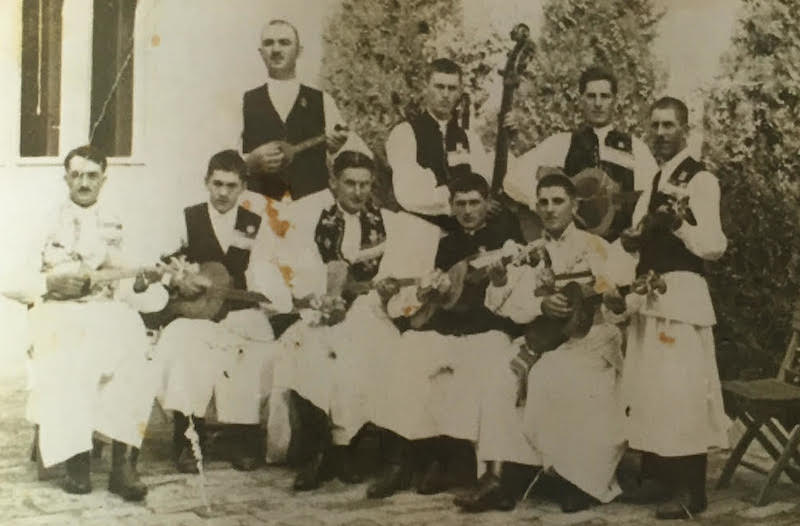
Bunjevci Croatians in Bačka: Tamburitza players from Tavankut 1938. Source Naco Zelić: Slikovali smo se.
Many thanks to Mr. Naco Zelić for permission to reproduce these photos here.
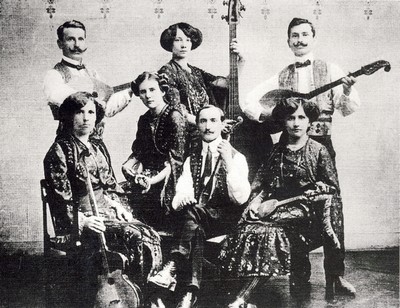
Tamburitza orchestra originating from Varaždin, Croatia, as guests in the USA, 1900.
Note a nice lady playing bass, which is rather unusual. Source: Mr. Vladimir Novak, Zagreb.
Kraj kapele sv. Ane Marko Vukasović, Stojdraga, Žumberak Dm Gm
U tankoj knjizi mojega života
A7 Dm
pronađe se mnoga lijepa strana
Dm Gm
al sreću ćutim ponajveću tada
A7 Dm
kad se sjetim mladenačkih dana.
F C
Slušam pjesme svojih prijatelja,
C Bb7 A7
slušam pjesme radosti i veselja.
Dm Gm E
Vidim dragu što me sad ostavlja,
C C7 F C7
nju mi srce još ne zaboravlja.
F
Kraj kapele svete Ane
C#+ Gm C7 F
prošla je mladost naša sva.
F C#+ GmC7
Mala tek klupa ona,
Gm C7 F F7
sve slatke naše tajne pričat zna.
Bb Bb0 F Dm
Tamo, sprovodili smo sretne dane,
Gm C7
u zagrljaju ljubavnom,
C7 Bb7A7 C7
u carstvu prirodnom.
F C#+
Kraj kapele svete Ane,
Gm C7 F
u samoborskom divnom kraju tom
Kapela sv. Ane is near the town of Samobor. 
www.croatoan.ca, Croatian folklore ensemble Croatoan, Ottawa, Canada
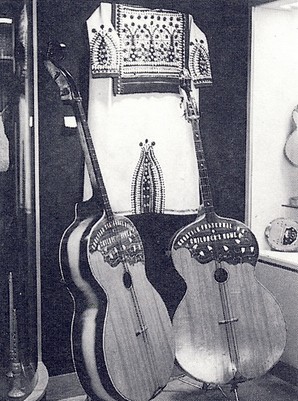
Tamburitza instruments exhibited in the Museum of Croatian Fraternal Union in Pittsburgh, USA.
Source: George Prpic, The Croatian Immigrants in America, New York, 1971.
Sidi Mara na kamen studencu Traditional Croatian song from Srijem Em Am B7
1. Sidi Mara na kamen studencu,
Am6 B7 Em
svoju tajnu otkrila je vincu.
G C G0 G
Suzama ga orosila Mara, |
G C G D7 G | 2x
sudbinu je svoju oplakala. |
2. Maro, Maro, od bisera grano,
Maro, Maro, sunce ogrijano.
Lipča si od biloga goluba,
pođi za me i budi mi ljuba.
3. Od lozice mladog vinograda,
Lipa Maro, pravi'ću ti lada.
Nosi'chu te na rukama dvima,
jer od mene boljeg momka nima.
4. Što che meni i srebro i zlato,
kad ja nimam što je srcu drago.
Imala sam svoga zaručnika,
bio mi je i ponos i dika.
vincu = vinac (vijenac) = here has the meaning of prayer-book (molitvenik) It is little known that this very old and popular Croatian song was originally sung in IKAVIAN dialect. Here we present its version from the city of Subotica, as the Bunjevci Croats used to sing until mid 20th century. I learned this from older people from Subotica, whose grandparents sang it like this. ĂĂĂĂĂĂĂÂ 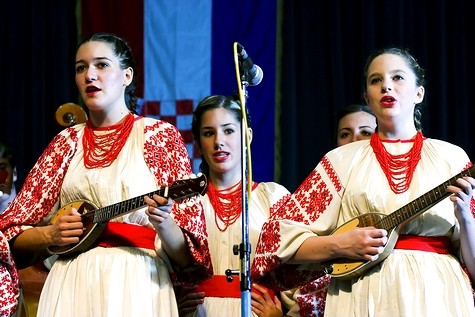
CroatiaFest 2005, Seattle, USA, Photo - Jal Schrof
It seems that "Sidi Mara..." is therigin for the melody of ALOHA OE (Farewell to Thee), famous Hawaiian song and the national anthem of Hawaii. Its words were written by Her Majesty Queen Liliuokalani around 1877. Possible Croatian origin for the melody of ALOHA OE is indicated in an article written by John Berger in HAWAII MAGAZINE, August 1996, p. 41. Very close relation between the melody of "Sidi Mara..." and ALOHA OE has been indicated by Branimir Vidmar, Timmins, Ontario, Canada, 1978. Vidmar also indicated that the melody is close to American gospel "How Great Thou Art," composed by K. Hine. It is also worth noting that "Sidi Mara..." has Austro-German version called Die Träne, and the English version is The Tear (this can also be seen from Vidmar's sheet music). As stated in Ripley's Believe it or not, Hawaiian music is the creation of a German bandmaster captain Henry Berger (1844-1929), invited to Hawaii by King Kamehameha V in 1872. Berger composed the first Hawaiian songs which "he adapted from German folk tunes." He composed 72 famous Hawaiian songs, including ALOHA OE and the Hawaiian national song. We can be pretty sure that the "German tune" adapted to Hawaiian ALOHA OE was in fact Croatian song "Sidi Mara...", which Berger obviously knew as "Die Träne."
I express my gratitude to Adam Eterovich, USA, for copies of sheet music which very clearly confirm the above views, and for the above mentioned article from Hawaii Magazine. It is also worth noting that, according to Eterovic, the husband Hawaiian Queen Liliuokalani was a Croata - John Dominis, whose father was born in Venice, and whose grandfather was born on the Croatian island of Brac, in the lovely town of Pucisca. Recall that Dominis = Gospodnetic, for example Marko Antun de Dominis. Eterovic believes that Hawaiian Queen could have opportunity to hear the Croatian song "Sidi Mara..." when she was hosted by the English Queen. 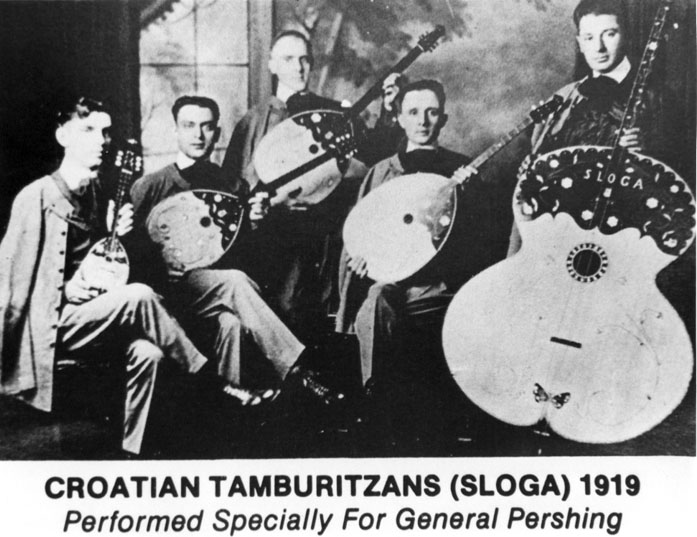
Very beautiful and original type of songs among Bunjevci Croats in Bačka are the so called groktalice. They are very emotional, sung slowly in a trembling voice, without any instrumental accompaniment. 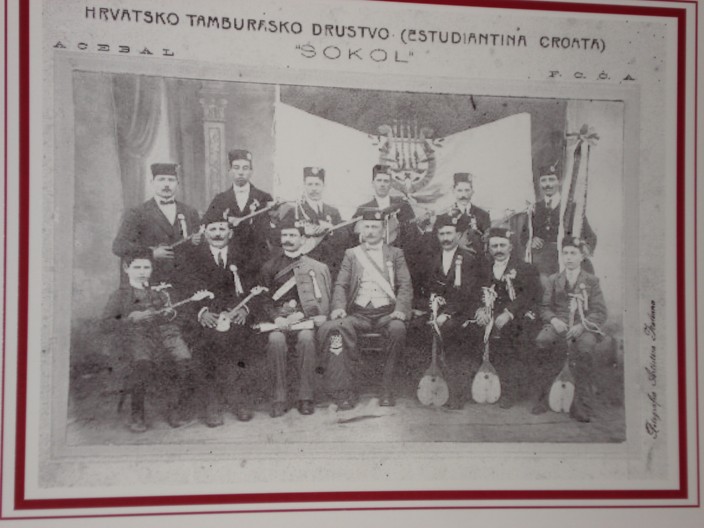
Croatian tamburitza orchestra Falcon - Hrvatski tamburaski orkestar Sokol,
Argentina, 1919 (from an exhibition Los Croatas en Argentina, Carmen Verlichak,
Matica iseljenika, Zagreb 2007)
Here is a well known children's verse from Subotica, as older people still remember: Eci, peci, pec,
ti si mali zec,
a ja mala pripelica,
eci peci pec. Note "pripelica" instead of "vjeverica"!
Veliko je more Traditional Croatian song A
Veliko je more,
A E
ne vidiš mu kraja.
E
Tamo u daljini
E A
sa nebom se spaja.
U dubini njemu
sto se čuda krije.
Galebova jato
nad njime se krije. Po njem bijela lađa
u daljinu plovi.
Na njoj su mornari
hrabri sokolovi. Na žalu su djeca,
molitvom ih prate,
da se svome domu
opet sretno vrate. I learned this song from my mother Katica Žubrinić b. Suntešić, and she learned it in 1942 from her school-teacher Štefica Rubin in Sveti Križ Začretje. 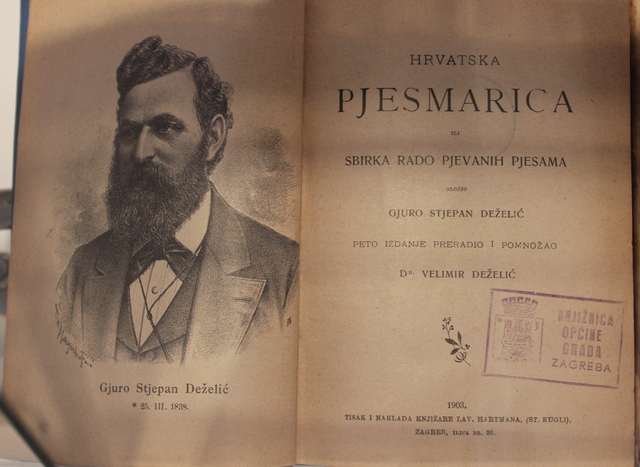
Gjuro Stjepan Deželić: Hrvatska pjesmarica, Zagreb, 1903.
ZAPIVAJ PISMU RIBARU STARI! Ribar plete mrižu svoju Traditional Croatian song D G D
1. Ribar plete mrižu svoju,
Bm Em A D
koja njemu triba.
G A D
A tko će je sutra plesti,
Bm Em A D D7
baš ga nije briga.
G D
Zapivaj pismu, ribaru stari,
Bm Em A D
jer to je pisma o moru. 2x
2. More divno, more plavo,
ti si meni drago.
Ti si čežnja srca moga,
ti si moje blago.
Biseru divni, rodnog mi kraja,
lipota tvoja me opaja.
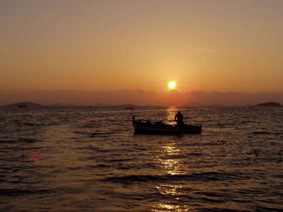
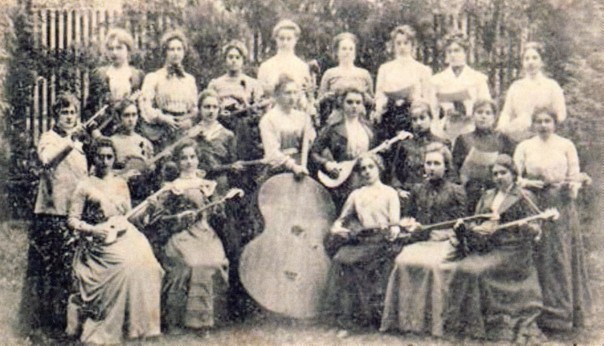
Tamburaški zbor "Kluba učiteljica" (Tamburitza orchestra of Women's Professor's Club, Vrbnik, island of Krk),
source: Prof. Mira Katunar, Vrbnik - grad "popi i mestric", Vrbnički Vidici, p 16, 2006, Vrbnik (photo around 1900?)
VILA VELEBITA A E
1. Oj ti vilo, vilo Velebita
E A
Ti našeg roda diko
A E
Tvoja slava jeste nama sveta
E A
Tebi Hrvat' kliko:
D A
R. Ti vilo Velebita
D A
Ti našeg roda diko.
A
Živila premila
A
Živila premila
D E A
Živila, oj premila
E A
Ti vilo svih Hrvata.
2. Velebite, vilovito stijenje,
ja ljubim tvoje smilje,
Ljubim tvoga u gorici vuka
ličkoga hajduka.
R.
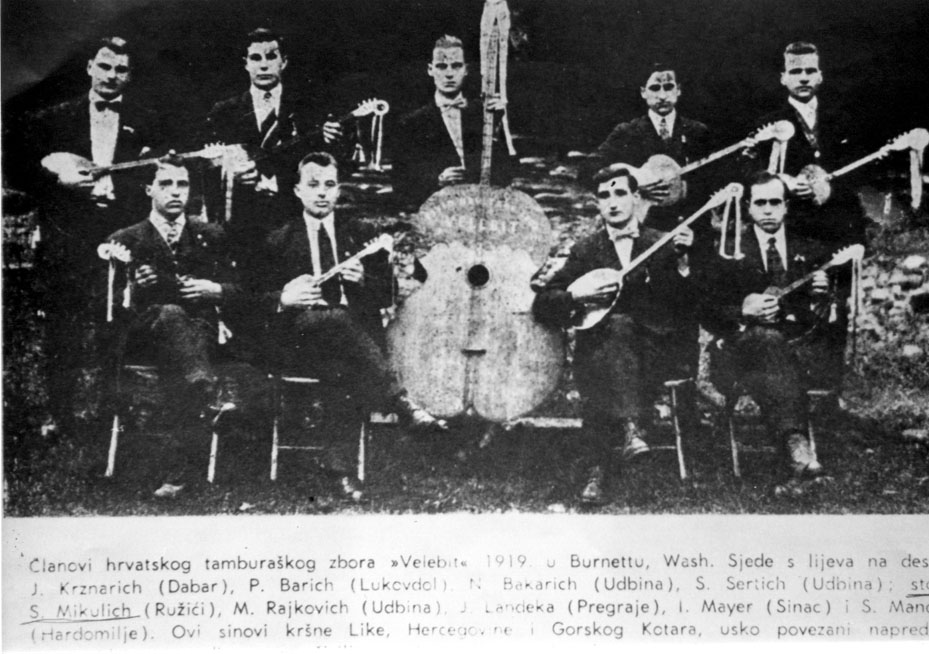
Tamburitza orchestra "Velebit" from Croatia in the USA, 1919
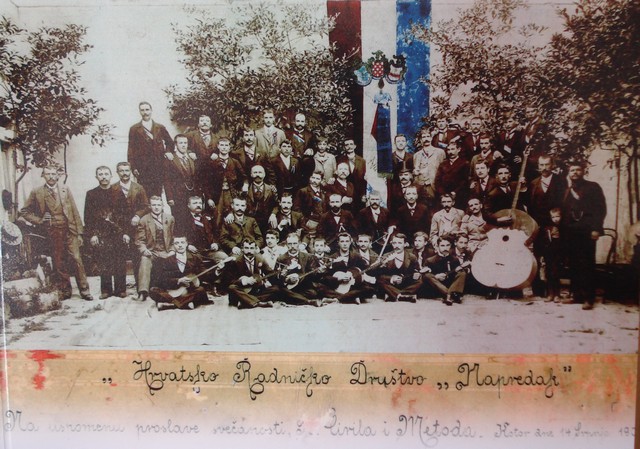
Croatian Working Society Progress (Hrvatsko Radničko Društvo Napredak), Kotor 1901
From the front cover page of Stolačko kulturno proljece, Godišnjak za povijest i kulturu, god. VII., 2009.
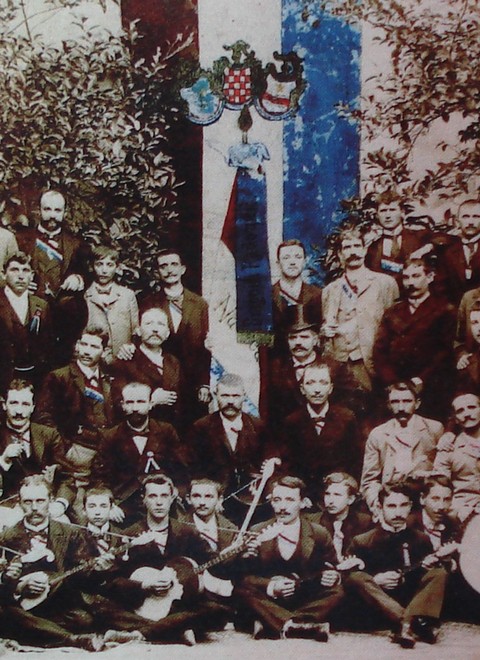
Note Croatian Coat of Arms on the tricolor flag

Croatian tamburitza players in Kotor in 1901
If you want to create excellent atmosphere at a birthday party, I suggest you the following very attractive traditional song from the north of Croatia, with fantastic music and verses: 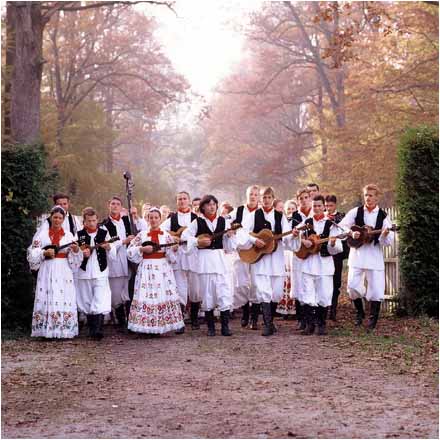 Dobro jutro moj svečaru (Rođendanska) Dobro jutro moj svečaru (Rođendanska)
Traditional from Podravina D G D
1. Dobro jutro moj svečaru,
D G D
dobro jutro ti želim!
D G D
Ja ti sviram, ja ti pjevam, |
Em A7 D | 2x
čestita-am ti rođendan! |
2. Sretna bila tvoja majka,
koja te je rodila!
Koja te je svojim mlijekom
na noge postavila!
3. Srebra nemam, zlata nemam,
nemam ništa da ti dam!
Samo ovu pjesmu pjevam,
za tvoj mili rođendan!
svečar = slavljenik
Many thanks to Mr. Robert Los for permission to use the above photo. One can hear very often the following variant instead the third stanza (you can add it as the fourth stanza if you want): 3' Mnogo ljeta sretan bio,
mnogo ljeta živio!
U ljubavi sretan bio,
mnogo lje-eta doži-ivio!
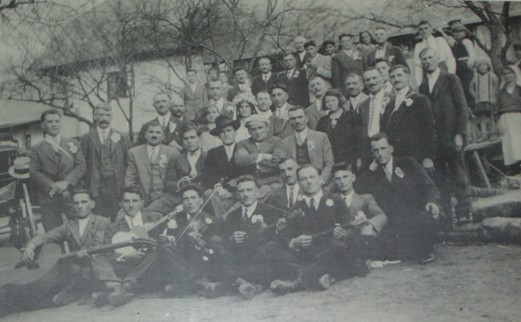
Wedding in Zumberak (near Zagreb), 1930.
Beautiful song about Zagreb in the kajkavian language. Za nikaj na svetu ja menjal te nebi Unofficial anthem of Zagreb, by Drago Brahm G B7 C G
1. Za nikaj na svetu ja menjal te nebi,
Am D7 G C G
moj Zagreb tak imam te rad!
G B7 C G
Svoj dom i veselje se našel vu tebi,
Am D7 G
za mene najljepši si grad!
C D7 G E7
Se vugle ti poznam, se vulice znam,
A7 Am7 D7
vu tebi sem srećen i nigdar nis' sam.
G B7 C E7
I gde god vu svetu, popeval bum rad,
A7 Am7 D7 G#+
tu malu popevku posluhni ju sa-ad:
G Am D7 G G7
R. Jer ti, ti, najdrajši si mi,
C D7 G Em
najslajša popevka v živlenju si mi!
C D7 G F E7
Vu mojemu srcu najlepši si grad,
Am7 D7 G C G
moj Zagreb tak imam te rad!
2. Nigdar se ne vrneju najljepši cajti,
kaj v tebi sem sprovel ih ja.
Ali ipak vu tebi ja štel bi se najti,
i srećen bi bil, to se zna.
Ja sikud bi išel, naluknul se rad,
z uspinjačom otpelal bi v gornji se grad.
Pogledal bi Zagreb, i kušlec mu dal,
još jenput spopeval kaj lepše bi znal!
R.
3. Se kaptolske hiže i vu njem se crkve
se blešćju v sunčeku sad.
Al' ipak to jesu najlepše starine
kaj ima ih naš gornji grad.
I Sava se cakli, i potoki si,
a z Gornjega Grada nam cinkuš zvoni.
I gda buš me Zagreb ti trebal il zval,
svoj život i srce za tebe bum dal!
R.
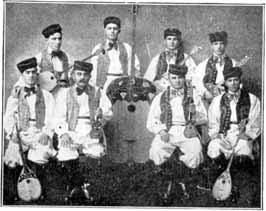
Croatian tamburitza orchestra in Buffalo, USA, 1887.
Bože čuvaj Hrvatsku
D Em A D
1. Bože čuvaj Hrvatsku,
D A D
moj dragi dom,
G A D Bm
ljude koji blaguju
Em A D
pri oltaru tvom.
2. Nek se sliju molitve,
sve u jedan glas.
Čuvaj ovo sveto tle,
blagoslovi nas.
Em A D
3. Ako treba Gospode,
Em A D D7
evo primi zavjet moj.
G A D Bm
Uzmi život od mene
Em A D
pa ga podaj njoj.
4. I u dobru i u zlu
budi s nama, budi s njom.
Bože čuvaj Hrvatsku,
moj dragi dom,
Bože čuvaj Hrvatsku, moj dragi dom.
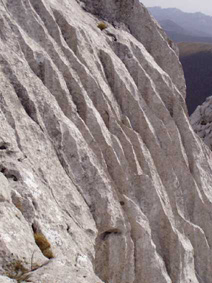
Interesting harmonic passages can be obtained in some of our folk songs using + (or aug) chords, for example in ``Poleg jene velke gore' or ``Kraj kapele sv. Ane'. 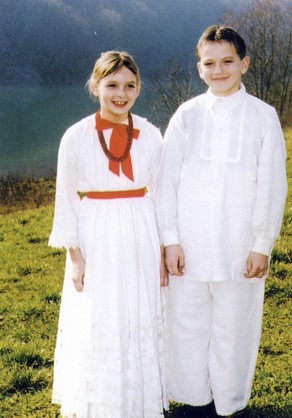
Croatian national costume from the Pokupsko region
(river Kupa, south of Zagreb).
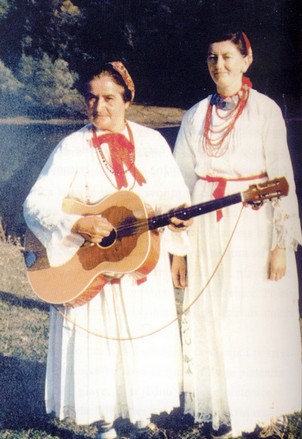
Croatian women from the Pokupsko region
(Kupa river south of Zagreb).
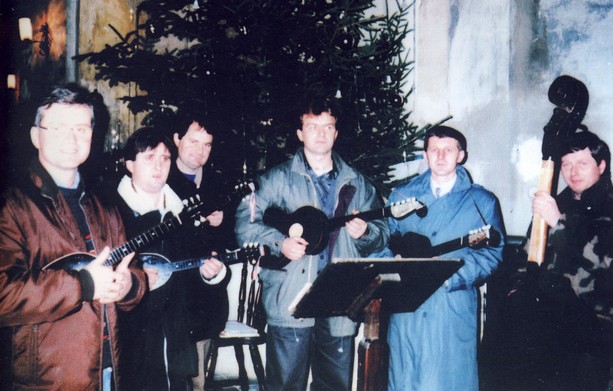
Pokupsko tamburitza players celebrating Christmas...
... in their ruined church on the left. Reproduced from [Pokupsko], many thanks to Mr. Božidar Škrinjarić for permission. On the right is the renovated church (2007), with three shattered bells in front of it, destroyed during the Greater Serbian agression in 1991. I hope that with these few musical examples I managed to convince You in the usefulness of back-cycling and parallel chords. You will hear them very often on recorded materials on the radio and elsewhere (just listen carefully). I assure you that Croatian folk provides an amazing amount of examples for many interesting harmonic mechanisms! If you don't believe, look at: 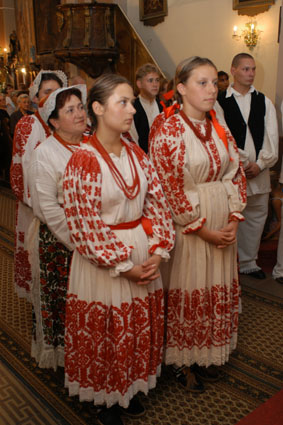
More details can be found in my booklet ``Gitara za radoznalce' (some libraries in Zagreb possess it). For those interested I must say that at this moment it is not available. Remark In the literature you will see the song ``Oj, jesenske duge noći' sometimes attributed to Branko Radičević, which is wrong (this error appears in my booklet as well!) - the author is Ivan Trnski, a Croatian poet. 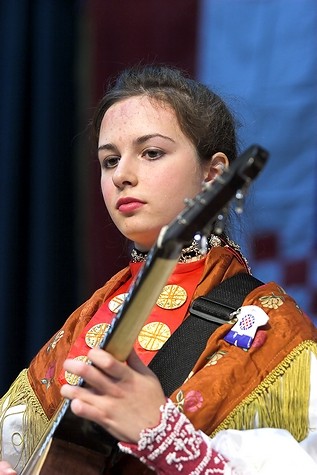
CroatiaFest 2005, Seattle, USA, Photo - Jal Schrof
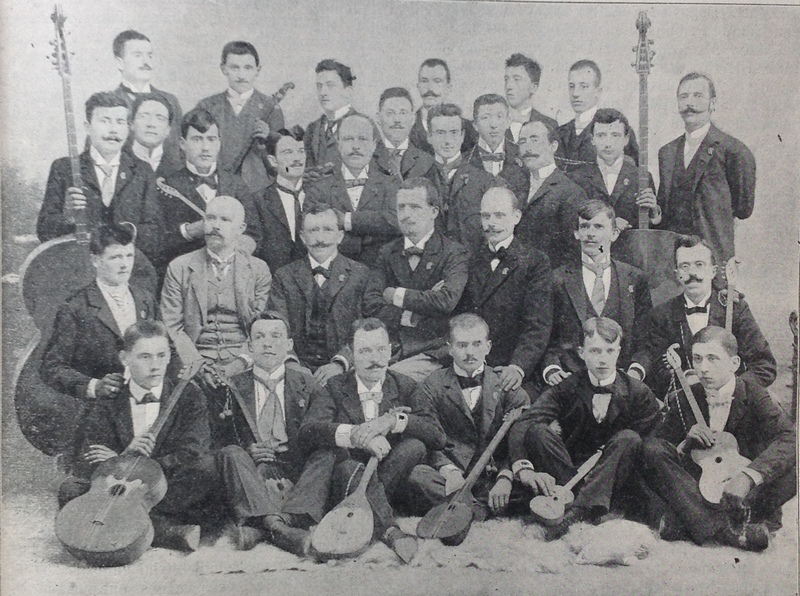
Singing and tamburitza society Laurel (Pjevačko i tamburaško društvo Lovor) from Opatija, not later than 1907.
Veliki Ćirilo-Metodski koledar za 1907., str. 85
A final remark (with best intentions): The Institute of Folklore in Zagreb possesses an extremely valuable collection of more than 2000 folk songs collected mostly among the Croats in Baccka and Srijem by dr. Josip Andrić (1894-1967). Unfortunately, they are still unpublished. Maybe this remark will be a necessary impetus to make this invaluable collection accessible to the wider audience, especially to those youngsters playing tamburitza. Our national instrument is an object of the study on the Academy of Music in Zagreb, similarly as done by other nations having their own national instruments. 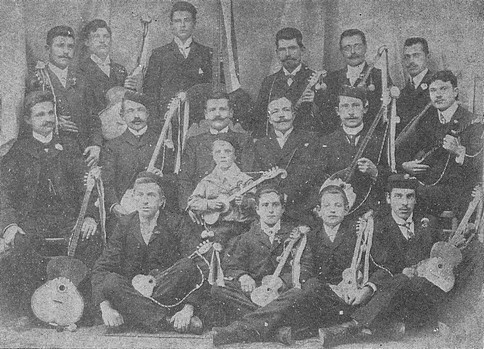
Croats in Punta Arenas, Chile (Magallanes region), with their tamburitzas
Croatian tamburitza band Tomislav in Punta Arenas, 1905
Hrvatsko tamburasko društvo Tomislav, Punta Arenas, 1905
(photo from Lj. Antić, Hrvati u J. Americi, Zagreb, 1991, pp 182 and 266)
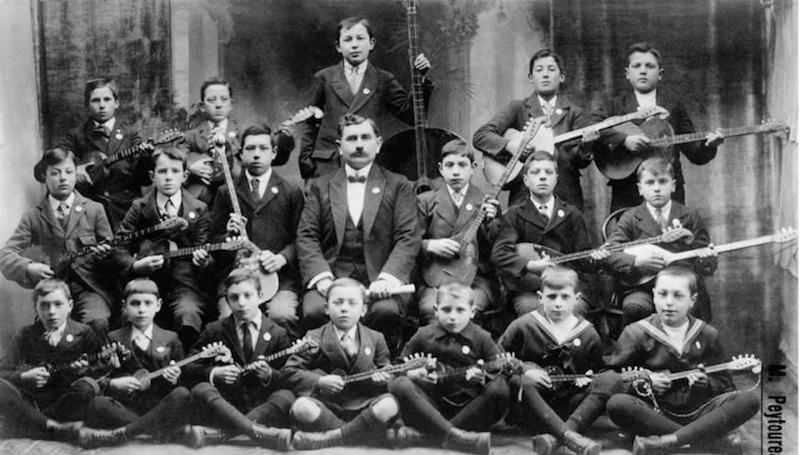
Hrvatsko tamburaško društvo Tomislav (Croatian tamburitza band Tomislav), Punta Arenas, Chile, 1916.
The most beautiful book I know, devoted to the thorough treatment of Croatian folk songs in Croatia as well as in Bosnia and Herzegovina and Serbia, comprising excellent photos of various dances and national costumes, is dr. Vinko Žganec: Hrvatske narodne pjesme (Croatian folk songs) published by Seljačka sloga, Zagreb 1951, with the parallel text in English. I saw it (to my greatest surprise) for the first time in May 1995. I suspect it was simply removed from our libraries in the fifties, for the reasons we can easily guess. Vinko Žganec collected more than 25,000 songs, among them 15,000 from his native Međimurje. 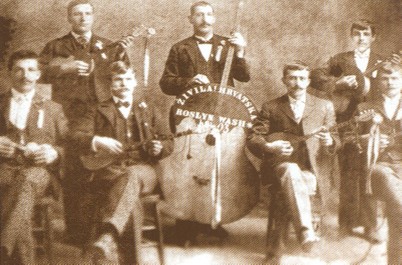
Tamburitza orchestra "Zivila Hrvatska" (Long Live Croatia), USA,
performed in White House for president F. Roosewelt in 1900.
I would recommend the reader an excellent book by Mr. Leopold, with a short history of tamburitza and accompanied with many Croatian folk songs, as well as some other references: - Mihael Ferić:
- Zasvirajte tambure 1, 2, Kulturni centar Gatalinka, Vinkovci, 2002 and 2003, ISBN:953-98989-1-9 and ISBN 953-98989-2-7 repectively
- Hrvatski tamburaški brevijar / The Croatian Tambura Breviary, Šokadija, Zagreb, 2011., fascinating book with 1300 photos on 500 pp.
- Siniša Leopold: Tambura u Hrvata, Golden marketing, Zagreb, 1995; for those wishing to know more about tamburitza play see
- Željko Bradić, Siniša Leopold: Skola za tamburicu, 2, kvartnog sustava, udzbenik za 1. i 2. razred osn. gl. skole, Skolska knjiga 92.
- Stipan Krekić: Tamburaška početnica, 84 str., Croatica, Budimpešta, 2003.
- Mate Kliković, Feri Sučić: Zajačimo si : zbirka najobljubljenijih hrvatskih jačak - 4. izd. s notami. - Željezno: Hrvatsko kulturno društvo u Gradišću - Kroatischer Kulturverein im Burgenland, 2003. - 159 str.
- Michael Savor: The Tamburitza and the preservation of Croatian folk music, on this web.
- Kolar, Walter W.: An Introduction to Croatian Musical Folklore, (Tamburitza) Pittsburgh, PA 1981
- Ivan Ivančan: Narodni plesni običaji Podravine 1., Kulturno-prosvjetni sabor Hrvatske, Zagreb 1989.
- Slavica i Lana Moslavac: Kad zasvira lane moje, Pjesme i plesovi Moslavine i hrvatske Posavine, Muzej Moslavine Kutina, Kutina 2007.,
ISMN M-9013596-0-4 - Slavko Topić, Niko Luburić: Duša naroda, Svjetlo riječi, Sarajevo - Zagreb, 2007., ISBN 978-953-7091-41-5
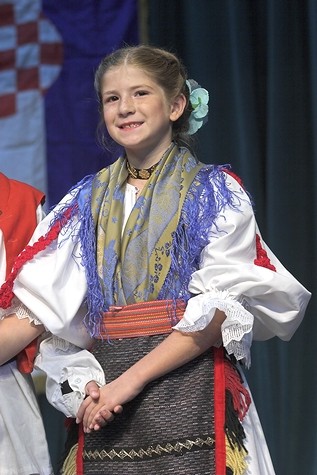
CroatiaFest 2005, Seattle, USA, Photo - Jal Schrof
Tamburica links in Austria: Tamburitza music in the USA: For further information (sheet music, collections etc.) please contact: - Muzička naklada, Zagreb, Nikole Tesle 10, Zagreb, tel. (+385-1) 481 14 41. Musical instruments.
- LADO
- Savez glazbeno-estradnih umjetnika izvođača Hrvatske, Zagreb, fax 01/445716,
- Školska knjiga.
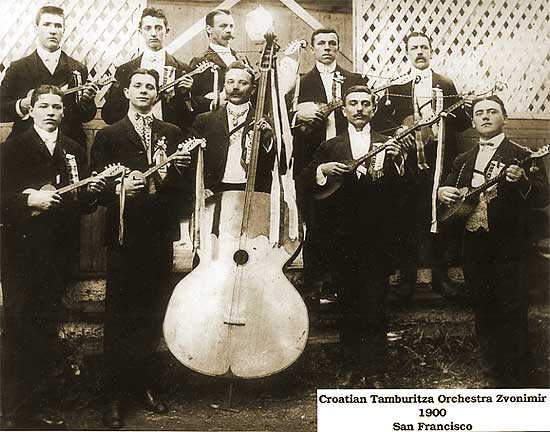
Croatian Tamburitza Orchestra Zvonimir, 1900, San Francisco, USA,
photo from Croatian American Web
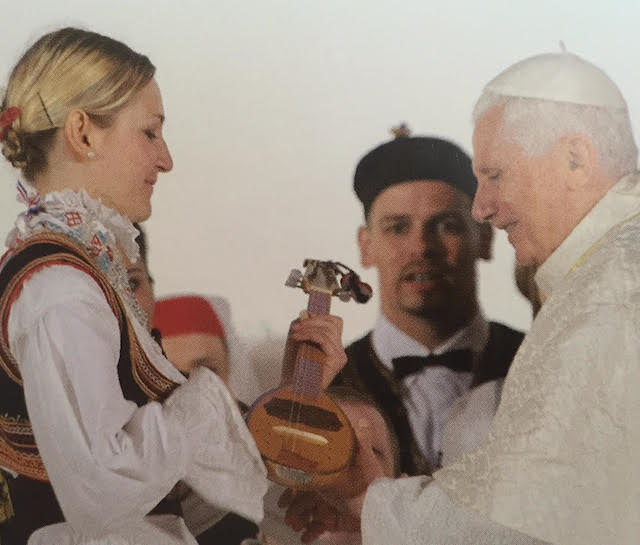
Tamburiza made by Andrija Franić from Županja, donated to Pope Benedict XVI
during his apostolic visit to Croatia in 2011.
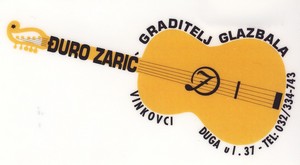
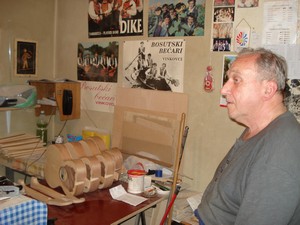
Mr. Đuro Zarić, Vinkovci, builder of tamburitzas
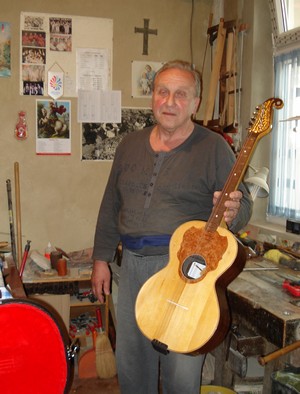
We would like to provide several addresses for those wishing to buy top quality tambura instruments (bisernica, prim, brač, bas prim, bugarija, čelo, bas): - Djuro Zarić, Vinkovci, Duga ul. 37, tel. +385 32 334 743
- G. Tatić, Osijek, Kneza Borne 85, tel. +385 54 163 606 (prim)
- Nikolić Ilija, Osijek, Medulinska 20, tel. + 385 54 557 224 (brac = bas-prim)
- Marinko Katulić, Croatia - 10417 Busevec, Novo Selo bb, tel. +385 1 765 238
- Ivan Djuretić, Velika Gorica, tel. +385 1 714 385
- Postojnski Stanko, Srebrnjak 109, Zagreb (metal strings for all tambura instruments)
- Mr Kos, Pitomača.
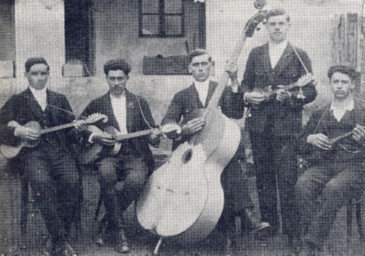
Tomo Kos, a well known builder of tamburas,
with his band from Pitomača, 1924 [Ivančan, p. 177]
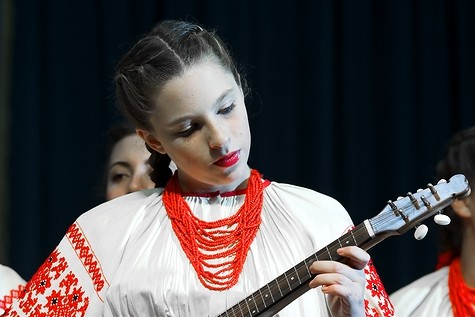
CroatiaFest 2005, Seattle, USA, Photo - Jal Schrof
Branimir Kvartuč: Đakovački vezovi (Đakovo Embroidery)
An overview of Croatian History, Culture and Science.
|